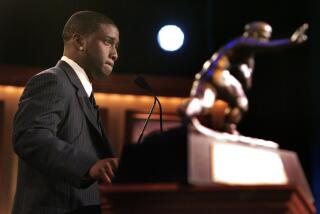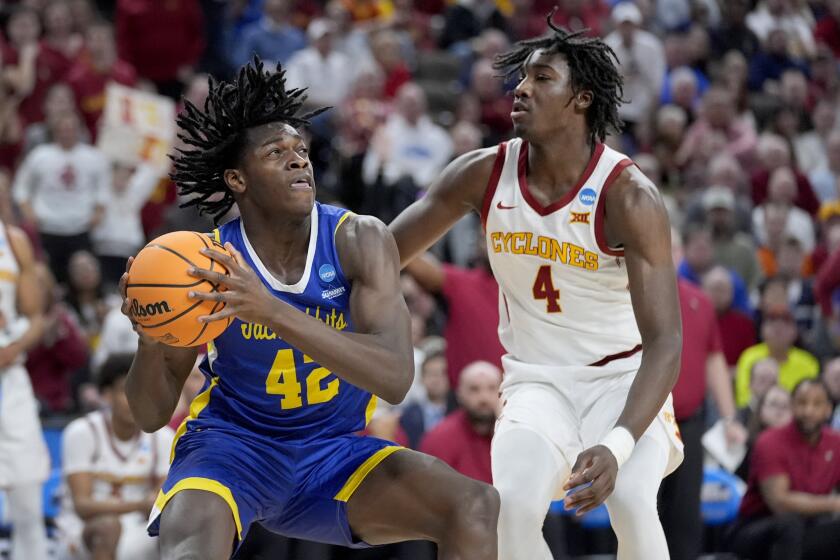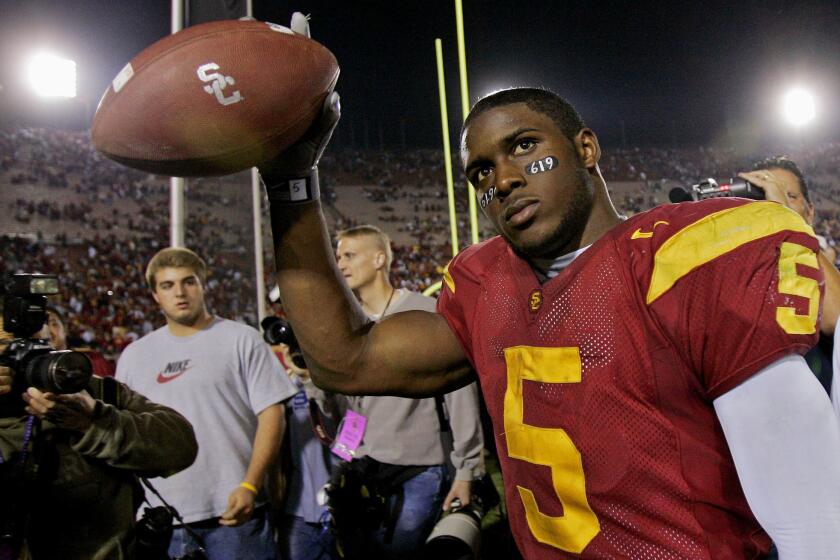This Won’t Be as Simple as A-T-P
Unity has been the word du jour of this sport, whether it’s been trotted out in meetings or used in carefully crafted releases about the future of tennis.
You could call it hands across the tennis net. But hands across the alphabet soup -- the ATP, the WTA and the ITF, the ruling bodies of the sport -- might be more accurate.
In an intriguing mission behind the scenes, the ATP is mounting an effort to receive what it calls “fairness” from the Grand Slam tournaments -- the Australian Open, the French Open, Wimbledon and the U.S. Open -- and the men’s tour is seeking the assistance of the women’s tour in its crusade.
Rough translation: It’s time to get a bigger bag of money from the Grand Slams.
During the just-completed tournament at Indian Wells, the ATP approached the women to see if the WTA wanted to go along for the charge up the hill. Lindsay Davenport, a member of the WTA’s player council, was in the meeting and described her initial reaction as being “a little floored.”
When was the last time the ATP sought the WTA’s help or advice on anything significant?
When did tennis first start being played with a ball?
According to Davenport, the men wanted the women to join their bid to negotiate with the Slams for a bigger piece of the compensation pie.
Davenport said the pitch from the men was, “It’s not necessarily about the money, it’s about the fairness to the players. That’s what was presented to us from the men’s side.”
There are two things to remember:
* When anyone says it’s not about the money, it’s always about the money.
* When anyone says “no problem,” you can be sure big problems lie ahead.
Davenport and Indian Wells champion Kim Clijsters attended the meeting, and Davenport said she could not determine how the Belgian felt about the issue. There will be a WTA players’ meeting at the coming tournament in Miami, and Davenport was undecided about her own stand.
“It’s my job to talk to the top players as their representative and see how they feel,” she said. “It’s so complicated to explain the percentages of why the men are going after it. It doesn’t look great, publicly, going after this money. It’s going to be a tough call to make and one that the women aren’t close to making yet.”
Adding to the mix is that this important issue is being raised when the WTA is essentially running on auto-pilot. Kevin Wulff has been a lame duck as chief executive since announcing his departure at the Australian Open, and second-in-command Josh Ripple is now a consultant.
Cooperation has not been common with the WTA and ATP. Animosity has been more the norm, players taking shots at the other tour, and the women have long memories about previous slights. One was the ATP’s perceived crowing about the $1.2-billion deal it struck with ISL in 1999, which imploded in 2001 after ISL went into bankruptcy.
At a tournament in Sydney, Australia, in January 2000, Davenport said, “the men had signs all over the place, ‘Apples are apples, oranges are oranges. We deserve to make more.’ To compare any women’s sport to a men’s sport is pointless. You can’t work as a team on some issues when you want to and not work together because then you laugh at the women’s product. My whole thing is, ‘OK, now you want us, now you don’t.’ ”
After years of fighting for equality, all of it on their own, the women today receive the same prize money as the men at two of the four Slams, the U.S. and Australian opens.
“It would have been nice if once, over the last 10 years, we had ever got support from the ATP tour on anything,” Davenport said. “That’s a huge point for myself. They definitely want our support to go forward with this. Do they really need it? It would certainly help, especially if they’re talking about being strong to the Slams.
“Overall, are the Slams being fair to us? Maybe not. Like I said, it would had been nice if we had an inkling of support on any issue. You’ve never heard [ATP CEO] Mark Miles say, ‘Maybe it’s time to consider equal prize money. Gosh, women’s tennis, look how exciting it is!’ ”
The timing is important for the ATP. Today, the new Wayne Ferreira-led trade association, the International Men’s Tennis Assn., is scheduled to have its first meeting in Miami.
On the eve of that meeting, coincidentally, the International Tennis Federation and the ATP released statements on the game’s future. The ITF, in regard to the meeting of the Grand Slam committee over the weekend in Lausanne, Switzerland, opened the door to a possible “new governance partnership” with the two tours.
The federation said, among other things, it was committed to a longer off-season for players and a series of combined or back-to-back events, lasting seven or eight days.
A few hours later, the ATP and WTA responded with a joint statement:
“In particular, although we understand the Grand Slam committee’s desire to strengthen their tournaments and Fed Cup/Davis Cup competitions, we disagree with the suggestion that no tournament other than the Grand Slams should be longer than eight days,” the statement said, citing the success of the events in Indian Wells and Miami.
It also addressed the issue of compensation, saying, “While we appreciate the Grand Slams’ comments regarding the need for them to support the international promotion of the game, and to provide fair rewards for professional players, we also remain concerned that their view of what is appropriate investment toward these ends is significantly less than what is required.”
The next move, apparently, belongs to the WTA.
“We’re in a great position here,” Davenport said. “We’re either following the men or choosing not to. We’re not rocking any boats. We’re not doing this on our own.”
More to Read
Get our high school sports newsletter
Prep Rally is devoted to the SoCal high school sports experience, bringing you scores, stories and a behind-the-scenes look at what makes prep sports so popular.
You may occasionally receive promotional content from the Los Angeles Times.







